Stretching across rugged mountains, the GR20 is known for its extreme difficulty and breathtaking views. This 180km route features steep climbs, rocky paths, and dramatic elevation changes, making it a true test of endurance.
Hikers face daily challenges, including navigating boulder fields and exposed ridges. With an average of 14km per day and 1,000m of elevation gain, preparation is key.
The rewards, however, are unmatched. Alpine peaks, dense forests, and coastal vistas create unforgettable scenery. The scent of wild maquis shrubs fills the air, adding to the experience.
Weather can shift quickly, from bright sunshine to sudden thunderstorms. Proper gear and planning ensure safety while tackling this legendary route.
Table of Contents
Key Takeaways
- This trek spans 180km with significant elevation changes.
- Daily hikes cover 14km and 1,000m of climbing.
- Terrain includes rocky paths and steep descents.
- Scenic views range from alpine peaks to coastal landscapes.
- Weather conditions can change rapidly.
What Is the GR20 Trail?
Corsica’s GR20 weaves through 120 peaks, demanding both skill and stamina. Part of the Grande Randonnée network, this route—numbered #20—stands apart with its technical scrambles and remote wilderness. Locally called fra li monti (“across the mountains”), it’s the only GR trail requiring rock-climbing techniques.
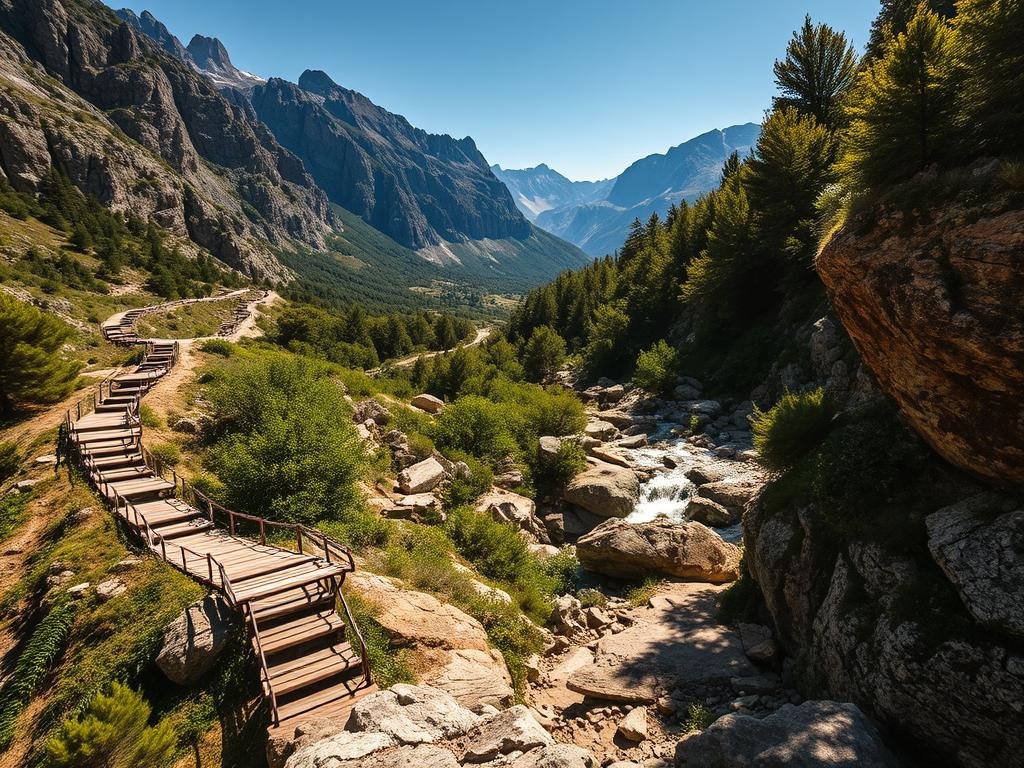
The History and Significance of a Legendary Hike
Established in 1972, the GR20 spans 180km across Corsica’s spine, hitting a max altitude of 2,600m. Its 12,000m total ascent tests hikers with cliffs and uneven terrain. The trail’s cultural roots run deep—Napoleon once roamed these same maquis shrublands.
Why This Route Stands Out
Unlike Italy’s Cinque Terre or Spain’s Camino, the GR20 combines extreme elevation with exposure. Waypoints like Cirque de Bonifatu and Monte Cinto (2,706m) highlight its raw beauty. Recent IGN map updates (2020) and Paddy Dillon’s guidebook help navigate its relentless shifts between bitter mornings and hailstorms.
Why the GR20 Is Considered Europe’s Toughest Hike
Few hikes push limits like the GR20, where every step tests endurance. Its 12,000m total ascent equals climbing Everest 1.5 times—spread over just 13 days. Add jagged granite slabs and 1,200m drops, and you’ve got a trek that breaks even seasoned hikers.

Brutal Elevation and Technical Terrain
Daily climbs average 900m, often over loose scree or near-vertical rock. Sections like Bocca Palmente demand scrambling skills with sheer drops on both sides. Eighty percent of the route lacks clear paths, forcing constant route-finding.
Ben Weeks, a veteran hiker, compares it to “walking up and down a Scottish Munro daily for 13 days”. The longest stretch covers 28km with 1,400m elevation change—a marathon with a mountain attached.
The Mental and Physical Toll of Two Weeks on the Trail
Predawn starts and refuge sleeping drain energy fast. Heat, hailstorms, and isolation amplify fatigue. Guides report a 75% dropout rate, often due to underestimated mental strain.
Group dynamics add pressure. Slow paces frustrate teams, while weather shifts demand quick decisions. Yet those who finish call it the ultimate test of mind and body—where every summit feels earned.
Planning Your GR20 Adventure
Your GR20 adventure hinges on two critical decisions: timing and direction. Get these right, and you’ll tackle the trail’s challenges with confidence. Weather windows and terrain difficulty vary dramatically, so research is key.
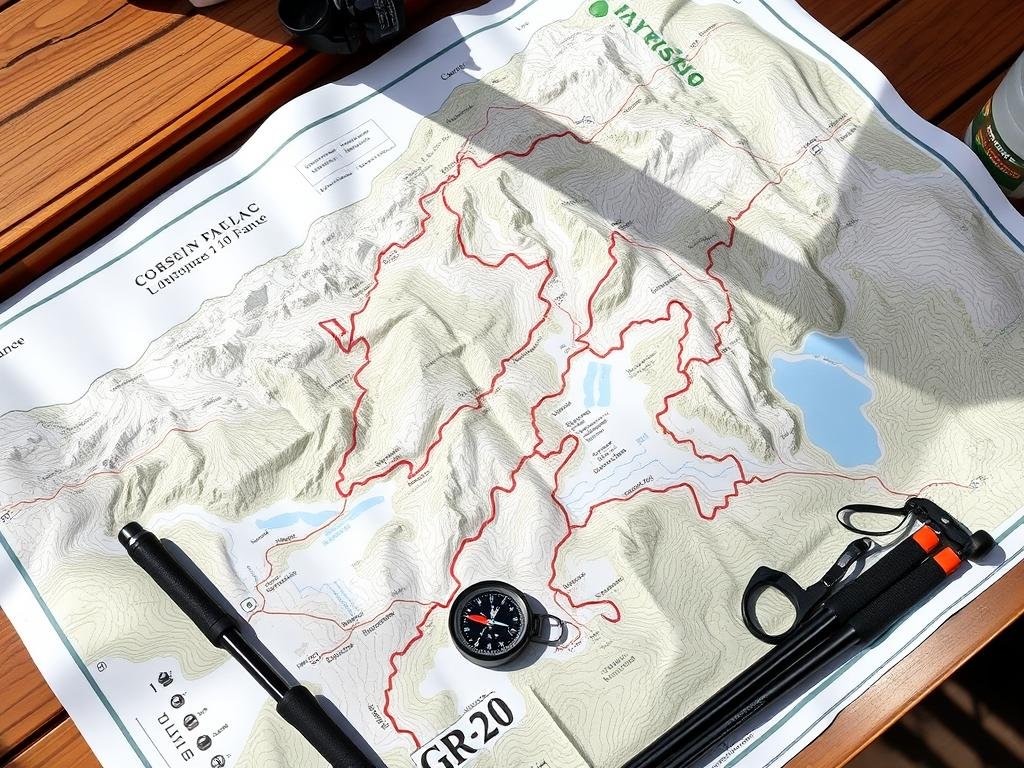
Best Time to Hike: Seasons and Weather Considerations
Late June to mid-July or late August to September offer the safest time to hike. Temperatures range from 30°C in valleys to 0°C at high camps. July and August bring crowds but guarantee open refuges.
October risks refuge closures, while early June may mean snow patches. Corsica’s weather shifts fast—pack layers and check forecasts daily.
Northbound vs. Southbound: Choosing Your Route
The northern section (Calenzana to Vizzavona) has the most technical terrain, with 60% of elevation gain in the first half. Southbound hikers face 23% steeper grades but avoid early exhaustion.
- Northbound pros: Gradual difficulty increase, better acclimatization.
- Southbound pros: Fewer crowds, quicker access to scenic highlights.
Since 2015, the route bypasses the closed Cirque de la Solitude. KE Adventure’s 15-day guided itinerary simplifies logistics with luggage transfers.
Essential Gear for the GR20
Every ounce matters when facing 1,000m daily elevation changes. Your pack becomes your lifeline, carrying everything from shelter to survival tools. Experts recommend keeping base weight under 10kg in a 40L rucksack—anything heavier slows progress on technical terrain.
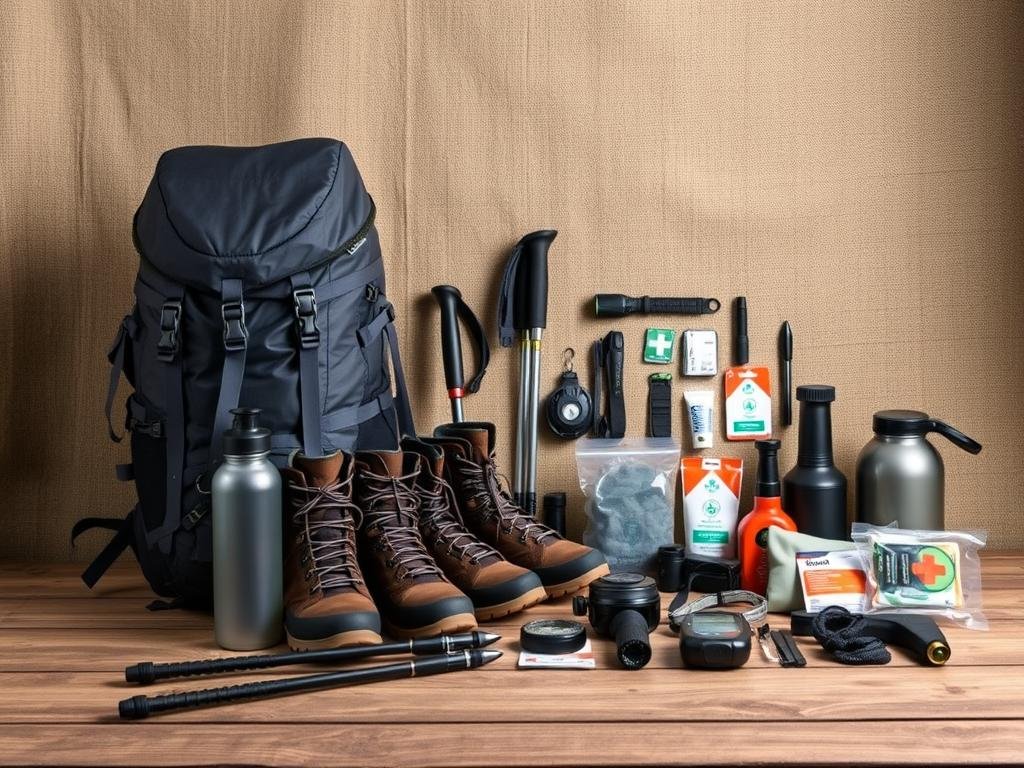
Footwear and Clothing: Balancing Comfort and Durability
The great footwear debate splits hikers between sticky rubber approach shoes and ankle-support boots. Approach shoes excel on rock scrambles but offer less protection during river crossings. For clothing, prioritize quick-dry fabrics that handle 0-30°C temperature swings.
Layer like a pro:
- Base layer: Merino wool for odor control
- Mid layer: Lightweight fleece
- Outer layer: Waterproof shell with pit zips
Must-Have Items for Scrambling and Extreme Weather
Climbing gloves prevent palm burns on granite slabs, while a 20L dry bag keeps gear safe during unexpected stream crossings. Don’t underestimate water needs—carry 3L daily using collapsible bottles or a hydration bladder.
Critical extras include:
- Head torch with 100+ lumen output
- Compact first aid kit with blister care
- Ear plugs for noisy refuge dormitories
Packing Light: What to Leave Behind
Ditch cotton (retains moisture) and heavy electronics. Instant porridge packets weigh less than cooking gear, while alcohol gel substitutes for bulky soap. If bringing a tent, choose ultralight models under 1.5kg—refuges often have space limitations.
Common overpacking mistakes:
- Multiple outfit changes
- Hardcover guidebooks
- DSLR cameras (phone cameras suffice)
Training for the GR20
Six months of targeted workouts can make or break your mountain experience. Experts like KE Adventure recommend this timeline to build the endurance and strength needed for 1,000m daily climbs. Skipping prep often leads to failure—80% of dropouts cite inadequate fitness.
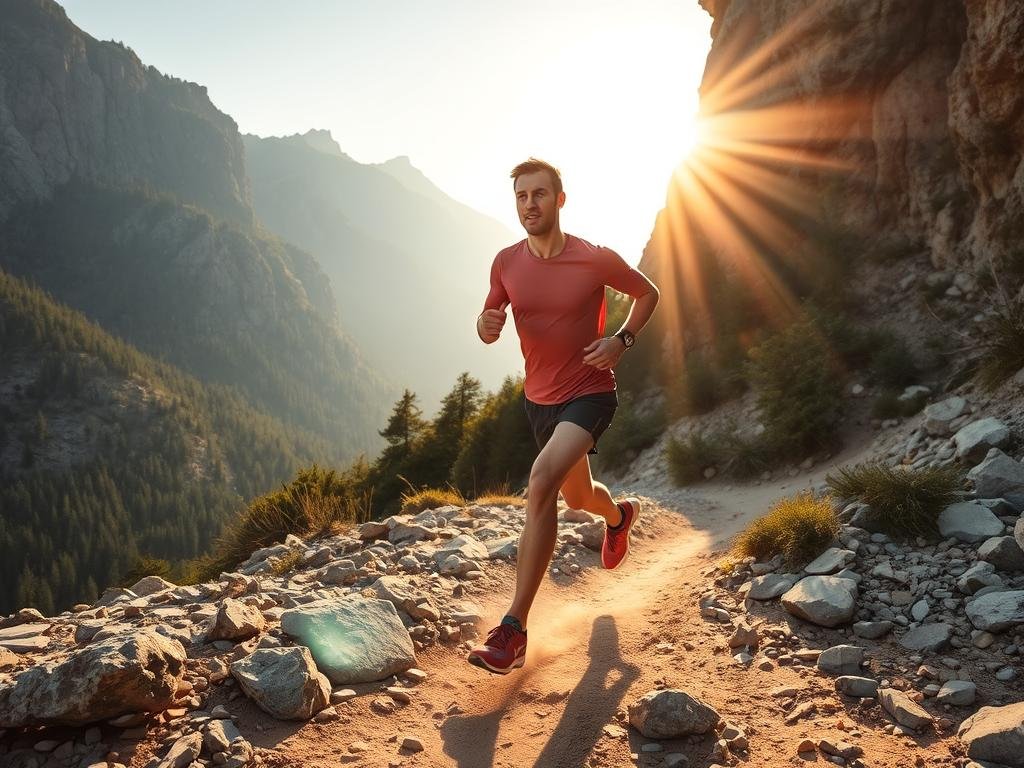
Building Endurance for Long Days on the Trail
Start with weekly 8-hour hikes carrying a 15kg pack. This simulates the trek’s demands, including rocky descents that strain quadriceps. Add back-to-back training days to mimic the relentless pace.
Group dynamics matter. Maintain a 4km/h minimum pace to avoid delays. Practice with IGN maps to sharpen route-finding skills—critical for remote sections.
Preparing for Scrambling and Exposure
Via Ferrata courses teach balance on exposed ridges. Focus on eccentric loading exercises to protect knees during steep drops.
Test gear in harsh weather. The sun can fade into hailstorms, requiring quick adaptability. Mental prep is key; even seasoned hikers report freezing mid-climb.
Pro Tip:Train with climbing gloves to grip granite slabs securely.
Navigating the GR20 Trail
Finding your way along this rugged path requires sharp attention to detail. The trail demands both physical stamina and navigational skills, with markers and maps as your lifelines. One wrong turn can add hours to your days, so preparation is crucial.
Understanding Trail Markers and Maps
Red-and-white stripes guide hikers along the route, with a 93% visibility rate in clear conditions. A red X means danger or wrong way, while double stripes confirm the correct path. Always carry IGN maps 4250 OT and 4251 OT—they detail every scramble and water source.
Key tools for staying on track:
- ViewRanger app with offline maps as GPS backup
- Compass for dense fog when visibility drops below 100m
- Physical guidebook as a failsafe for tech failures
Common Pitfalls and How to Avoid Them
Nearly 22% of wrong turns happen between Bergeries de Vallone and Vizzavona. The Spasimata footbridge becomes treacherous when wet—test each step carefully. Water sources below bergeries may be contaminated; always fill up at higher springs.
Critical safety protocols:
- Never separate your group in poor visibility
- Check weather updates at every refuge
- Mark risky sections on your map before starting
The island‘s terrain shifts rapidly, from granite slabs to loose scree. Staying alert prevents most navigation errors. With proper tools and awareness, you’ll conquer each challenging section safely.
A Day-by-Day Breakdown of the GR20
This legendary trek unfolds over 15 challenging days, each offering unique landscapes and tests. The route divides into three distinct phases, with elevation changes that demand careful pacing and preparation.
Days 1-4: The Northern Section’s Steep Challenges
The first four days deliver the toughest climbs. Day 1 starts with a 12km hike and 1,500m ascent to Ortu di u Piobbio refuge—a brutal introduction. By Day 3, you’ll scramble through Cirque de Bonifatu’s granite walls before reaching Sheepfolds of Vallone after 7.5km and 1,200m ascent.
Key northern highlights:
- Haut Asco’s rock scrambles requiring handholds
- Castel di Vergio’s dense forests providing shade
- Thunderstorms that frequently strike afternoon climbs
Days 5-10: Alpine Views and High Passes
The central section rewards effort with panoramic vistas. Day 5’s 1,600m ascent to Lac de Nino reveals wild horses grazing near turquoise waters. Petra Piana refuge offers sunrise views over Lake Melo—worth the 910m climb on Day 7.
Mid-trek essentials:
| Day | Distance | Ascent | Highlight |
|---|---|---|---|
| 6 | 16km | 950m | Refuge de Carrozu’s sunset |
| 8 | 17km | 1,400m | L’Onda’s panoramic ledges |
| 10 | 16km | 1,000m | Uscuiolu’s shepherd encounters |
Days 11-15: The Final Push Through Bavella
The southern stretch mixes rugged mountain passes with coastal air. Day 13’s 23.5km Bavella stage features a 1,400m descent past the iconic Aiguilles spires. Resupply at Conca (Day 14) before the last push to Col de Bavella.
Final challenges include:
- Coscione plateau’s deceptive navigation
- Bocca di Chiralba’s exposed ridges (Day 15)
- Sudden hailstorms near Vizzavona
Alternative itineraries range from 7-day speed attempts to 20-day photography-focused hikes. Choose based on fitness and goals.
Where to Sleep on the GR20
Rest spots along the route range from rustic huts to tent sites under the stars. Each option suits different budgets and comfort levels, with refuges offering social hubs and tenting providing privacy. Book early—spots fill fast in peak season.
Mountain Refuges: What to Expect
Refuges charge €15 for a mattress in shared dorms, often with basic foam pads and bunk beds. Popular stops like Manganu (Day 5) and Petra Piana (Day 6) feature stunning views but cramped quarters.
Etiquette is strict: lights out by 8:30PM, no shoes indoors, and limited charging ports. Pack earplugs—generators and snorers disrupt sleep. A silk sleeping bag liner wards off bed bugs reported by 40% of hikers.
Tenting vs. Huts: Pros and Cons
Tenting costs €8/night but risks exposure to storms. Refuges provide shelter but lack privacy. Compare options:
| Option | Cost | Pros | Cons |
|---|---|---|---|
| Refuge | €15 | Social, includes meals | Noisy, bed bugs |
| Tent | €8 | Quiet, flexible | Weather risks |
Dinners at refuges like l’Onda cost €18 for pasta, soup, and cheese. For budget meals, pack dehydrated food and lightweight cutlery. As noted in this trail journal, secure food from wildlife—mice and foxes scavenge loose items.
Pro Tip: Hôtel Castel di Vergio offers a mid-trek reset with private rooms and hot showers.
Food and Water on the Trail
Fueling your body properly is as critical as your gear for this demanding trek. With 3,500+ calories burned daily, strategic meal planning and hydration are non-negotiable. Local specialties like fiadone cheesecake and brocciu cheese add flavor to the journey.
Meal Planning and Resupply Points
Refuges serve carb-heavy dinners—pasta, rice, and soups—to replenish energy. For self-supplied meals, stock up in Bastia, Vizzavona, or Conca with lightweight staples:
- 200g nuts/day for sustained energy
- Corsican cured meats (no refrigeration needed)
- Dehydrated meals for tent nights
Bread and homemade wine are available at bergeries (shepherd huts). Pack a folding knife to slice cheese and sausages easily.
Staying Hydrated in Corsica’s Sun
Water sources appear at every campsite, but treatment is essential. Compare options:
| Method | Speed | Weight |
|---|---|---|
| Katadyn BeFree filter | Fast flow | 2.1oz |
| Chemical tablets | 30-min wait | 0.5oz |
South-facing climbs like Bavella’s ascents demand extra water—carry 3L and sip hourly. Celebrate finishing with Mirto liqueur, a local digestif.
Highlights and Challenges of the GR20
Guided groups triple completion rates compared to solo attempts, with 92% reaching the finish line. This route blends world-class views with relentless terrain, creating a transformative experience.
Unforgettable Scenery and Wildlife Encounters
The alpine landscape shifts from maquis shrublands to granite spires. At Lac de Nino, wild horses graze near turquoise waters, while Tyrrhenian wall lizards dart across sunbaked rocks.
Sunset at Bocca a u Saltu paints the sky in fiery hues. The scent of wild herbs mixes with crisp mountain air, heightening the sensory experience.
Overcoming the Trail’s Toughest Sections
Pointe des Éboulis tests hikers with loose scree and 1,200m drops. Compatible pacing prevents group friction—slow movers add hours to steep climbs.
The Bavella Needle traverse demands focus. One misstep on exposed ridges risks injury, but success here fuels lasting pride.
Post-hike, tradition calls for boot-dipping in the Mediterranean at Conca. It’s a symbolic farewell to Corsica’s rugged beauty.
Conclusion
Completing this legendary trek transforms both body and mind. For 87% of hikers, it ranks as a top life adventure, blending brutal climbs with unmatched rewards.
The key takeaway? Physical prep and mental resilience forge success. Train in the UK’s Snowdonia or Scottish Highlands to simulate the trail’s demands.
For expert guidance, KE Adventure’s trips streamline logistics. Remember: “The GR20 doesn’t get easier—you get stronger.” Now’s the time to plan your journey.
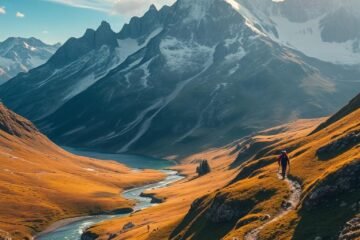
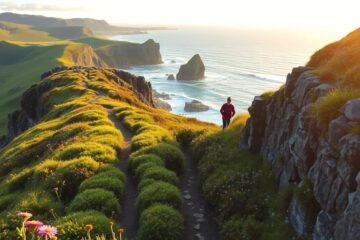

0 Comments